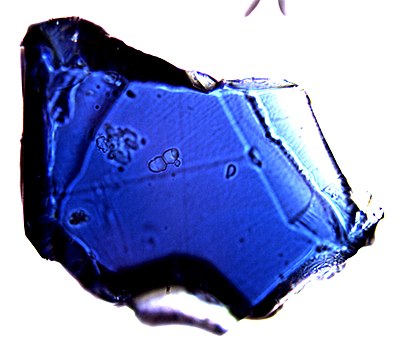Benutzer:Christian b219/Ringwoodit
| Ringwoodit | |
|---|---|
 | |
| Allgemeines und Klassifikation | |
| Chemische Formel | (Mg,Fe2+)2(SiO4) |
| Mineralklasse (und ggf. Abteilung) |
Nesosilicates Spinel structural group |
| System-Nummer nach Strunz (9. Aufl.) |
09.AC.15 |
| Kristallographische Daten | |
| Kristallsystem | Cubic |
| Kristallklasse; Symbol | Isometric hexoctahedral H-M symbol: 4/m32/m Space group: Fd3m |
| Physikalische Eigenschaften | |
| Mohshärte | Bitte ergänzen |
| Dichte (g/cm3) | 3.564 (Fo100); 3.691 (Fo90); 4.845 (Fa100) |
| Spaltbarkeit | Bitte ergänzen |
| Farbe | Deep blue, also red, violet, or colourless (pure Mg2(SiO4)) |
| Strichfarbe | Bitte ergänzen |
| Transparenz | Semitransparent |
| Glanz | Bitte ergänzen |
| Kristalloptik | |
| Doppelbrechung | δ = nicht vorhanden |
| Optischer Charakter | Isotropic |
| Pleochroismus | nicht vorhanden |
Ringwoodit ist das Hochdruck-Polymorph der Olivin-Mineralgruppe. Es ist ab hohen Temperaturen und Drücken im Erdmantel zwischen 525 und 660 km Tiefe stabil. Das Mineral wurde als erstes 1969 im Tenham-Meteoriten identifiziert,[4] und es wird angenommen, dass es im Erdmantel in großen Mengen vorkommt. Es wurde nach dem australischen Wissenschaftler Ted Ringwood (1930–1993) benannt, der polymorphe Phasenübergänge von den weitverbreiteten Mantelmineralen Olivin und Pyroxen bei Drücken und Temperaturen äquivalent zu Tiefen von etwa 600 km untersuchte. Olivine, Wadsleyit und Ringwoodite sind Polymorphe im oberen Erdmantel. In Tiefen größer als 660 km sind andere Minerale, einschließlich einiger mit Perovskit-Struktur, stabil. Die Eigenschaften dieser Minerale bedingen viele Eigenschaften des Erdmantels.
Vorkommen[Bearbeiten | Quelltext bearbeiten]
Als Ergebnis von Schockmetamophose[Bearbeiten | Quelltext bearbeiten]
In Meteoriten tritt Ringwoodit in Venen von abgeschreckten Impaktschmelzen auf, welche diskordant die Matrix schneiden und Olivin ersetzen.[1]
Im Erdmantel[Bearbeiten | Quelltext bearbeiten]
Im Erdinneren macht die Mineralgruppe Olivin einen bedeutenden Teil im oberen Erdmantel aus, dementsprechend wird davon ausgegangen dass in Tiefen geringer als 410 km, Ringwoodit einen großen Teil der Mantelübergangszone zwischen 520 und 660 km Tiefe ausmacht. Seismic discontinuities at about 410, 520, and 660 km depth have been attributed to phase changes involving olivine and its polymorphs. The 520-km discontinuity is generally believed to be caused by the transition of the olivine polymorph, wadsleyite (beta-phase) to ringwoodite (gamma-phase), while the 660-km discontinuity by the phase transformation of ringwoodite (gamma-phase) to a silicate perovskite plus magnesiowüstite.[2][3] Ringwoodite in the lower half of the transition zone is inferred to play a pivotal role in mantle dynamics, and the plastic properties of ringwoodite are thought to be critical in determining flow of material in this part of the mantle. The solubility of hydroxide in ringwoodite is important because of the effect of hydrogen upon rheology. Ringwoodite synthesized at conditions appropriate for the transition zone has been found to contain up to 2.6 weight percent water.[4][5] Because the transition zone between the Earth’s upper and lower mantle helps govern the scale of mass and heat transport throughout the Earth, the presence of water within this region, whether global or localized, may have a significant effect on mantle rheology and therefore mantle circulation.[6] In regions of subduction zones, the ringwoodite stability field hosts high levels of seismicity.[7]
Chemische Zusammensetzung[Bearbeiten | Quelltext bearbeiten]
Ringwoodit Zusammensetzungen reichen von reinem Mg2SiO4 zu reinem Fe2SiO4, ausserdem können bis zu 2,6 Masse-% H2O im Kristallgitter eingebaut werden.[8]
Einzelnachweise[Bearbeiten | Quelltext bearbeiten]
- ↑ Chen. M, El Goresy A., and Gillet P. (2004) Ringwoodite lamellae in olivine: Clues to olivine–ringwoodite phase transition mechanisms in shocked meteorites and subducting slabs. PNAS
- ↑ Deuss A., Woodhouse J. (2001) Seismic Observations of Splitting of the Mid-Transition Zone Discontinuity in Earth's Mantle Science, New Series, Vol. 294, No. 5541. (Oct. 12, 2001), pp. 354–357.
- ↑ G. R. Helffrich and B. J. Wood (2001) The Earth's mantle, Nature 412, 501-507.
- ↑ Kohlstedt, D.L., Keppler H., and Rubie, D.C. (1996) Solubility of water in the alpha, beta, and gamma phases of (Mg,Fe)2SiO4. Contributions to Mineralogy and Petrology, 123, 345–357.
- ↑ Smyth, J. R., Holl, C. M., Frost, D. J., Jacobsen, S. D., Langenhorst, F., and McCammon, C. A. (2003) Structural systematics of hydrous ringwoodite and water in Earth’s interior. American Mineralogist, v. 88, pp. 1402–1407
- ↑ Kavner A. (2003) Elasticity and strength of hydrous ringwoodite at high pressure. Earth and Planetary Science Letters 214 (2003) 645-654
- ↑ Xu. Y., Weider D.J., Chen J., Vaughan M.T., Wang Y., and Uchida T. (2003) Flow-law for ringwoodite at subduction zone conditions. Physics of the Earth and Planetary Interiors 136 (2003) 3–9.
- ↑ Ye, Y., D.A. Brown, J. R. Smyth, W.R. Panero, S.D. Jacobsen, Y.-Y. Chang, J.P. Townsend, S.M. Thomas, E. Hauri, P. Dera, and D.J. Frost (2012) Compressibility and thermal expansion study of hydrous Fo100 ringwoodite with 2.5(3) wt% H2O. American Mineralogist 97, 573-582.